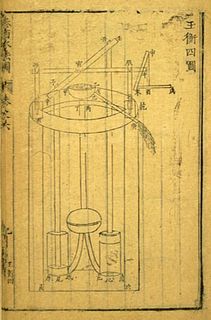
Giulio Aleni, in Chinese Ai Rulüe, was an Italian Jesuit missionary and scholar. He was born in Leno near Brescia in Italy, at the time part of the Republic of Venice, and died at Yanping in China. He became a member of the Society of Jesus in 1600 and distinguished himself in his knowledge of mathematics and theology.

Zhaoqing, formerly romanized as Shiuhing, is a prefecture-level city in Guangdong Province, China. During the 2010 census, its population was 3,918,467, with 1,232,462 living in the urbanized areas of Duanzhou and Gaoyao. The prefectural seat—except the Seven Star Crags—is fairly flat, but thickly forested mountains lie just outside its limits. Numerous rice paddies and aquaculture ponds are found on the outskirts of the city. Sihui and the southern districts of the prefecture are considered part of the Pearl River Delta.

Sancai Tuhui, compiled by Wang Qi and his son Wang Siyi, is a Chinese leishu encyclopedia, completed in 1607 and published in 1609 during the Ming dynasty, featuring illustrations of subjects in the three worlds of heaven, earth, and humanity.
Michele or Michael Ruggieri, born Pompilio Ruggieri and known in China as Luo Mingjian, was an Italian Jesuit priest and missionary. A founding father of the Jesuit China missions, co-author of the first European–Chinese dictionary, and first European translator of the Four Books of Confucianism, he has been described as the first European sinologist.

Johann(es) Schreck, also Terrenz or Terrentius Constantiensis, Deng Yuhan Hanpo 鄧玉函, Deng Zhen Lohan, was a German Jesuit, missionary to China and polymath. He is credited with the development of scientific-technical terminology in Chinese.

Taipei Ricci Institute (TRI) in Taipei, Taiwan, is one of four Ricci Institutes.

Sabatino de Ursis was an Italian Jesuit who was active in 17th-century China, during the Jesuit China missions.
Diego de Pantoja or Diego Pantoja was a Spanish Jesuit and missionary to China who is best known for having accompanied Matteo Ricci in Beijing. His name also appears in some sources as Didaco Pantoia.

De Christiana expeditione apud Sinas suscepta ab Societate Jesu ... is a book based on an Italian manuscript written by the most important founding figure of the Jesuit China mission, Matteo Ricci (1552–1610), expanded and translated into Latin by his colleague Nicolas Trigault (1577–1628). The book was first published in 1615 in Augsburg.
Louis J. Gallagher, SJ was an American Jesuit, known for his educational and literary work.

The Kunyu Quantu, or Full Map of the World, was a map of the world developed by Jesuit father Ferdinand Verbiest during his mission in China in 1674. A copy is in the Hunterian Museum.
The year 1584 in science and technology included many events, some of which are listed here.

The Zhifang Waiji was an atlas written by various Italian Jesuits in China in the early seventeenth century. The name literally refers to lands beyond the purview of the Zhifang Si, the Imperial cartography office. It was the first detailed atlas of global geography available in Chinese.
Siu-Leung Lee (李兆良), Ph.D., is the President of Zheng He Society of the Americas, Washington, DC, and editor of Midwestern Epigraphic Society in Columbus, Ohio.
Yu Xi, courtesy name Zhongning (仲寧), was a Chinese official, scholar, and astronomer of the Jin dynasty. He is best known for his discovery of the precession of the equinoxes, independently of the earlier ancient Greek astronomer Hipparchus. He also postulated that the Earth could be spherical in shape instead of being flat and square, long before the idea became widely accepted in Chinese science thanks to the European influence of the Jesuits in the 17th century.















